


F-100 Super Sabre - $$7.50
The North American Super Sabre F-100 was a product of the pioneering days a jet fighter development in the fifties. The Super Sabre was the first western fighter capable of breaking the sound barrier during level flight. The first YF-100 flew in May 1953 and entered service with the USAF the following year. It was the first of the Century Fighter series.
The Valorous North American F-100 Super Sabre 'Hun'
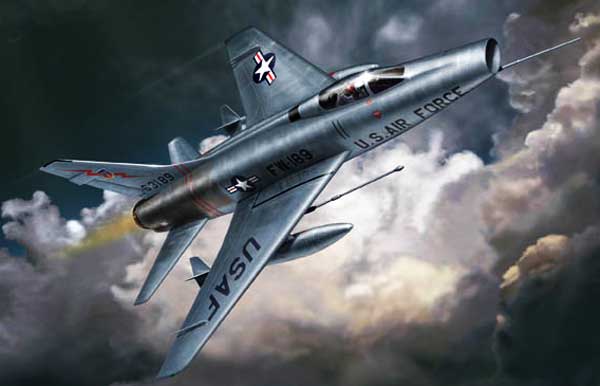
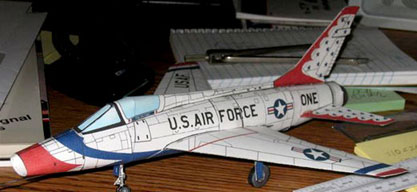
The North American 'Super Sabre' F-100 was a product of the pioneering days of jet fighter development in the fifties.
The Super Sabre was the first western fighter capable of breaking the sound barrier during level flight.
The first YF-100 flew in May 1953 and entered service with the USAF the following year. It was the first of the 'Century Fighter' series.
This is another design by artist Rob Carleen. He's also created
a model for the Vought A-7.
Ya just gotta love it; a few days ago you send an aircraft that looks like it it flying backwards, and now you send an aircraft that flew like a bat-outta-hell. First time that I saw the Thunderbirds the F-100 was their mount. One of the solo pilots did an on-the-deck pass down the flight line with the afterburner in full "on" position. Impressed this little 10-yr-old for sure. Thanks for all of the liveries. ymp, John
The F 100 was very colorful in the late 50s. I used to watch the 2 New Mexico F 100s standing alert during the day go out at dusk with the afterburner going, great show. Thanks for all the great models. Ron Sheaffer
North American F-100 Super Sabre
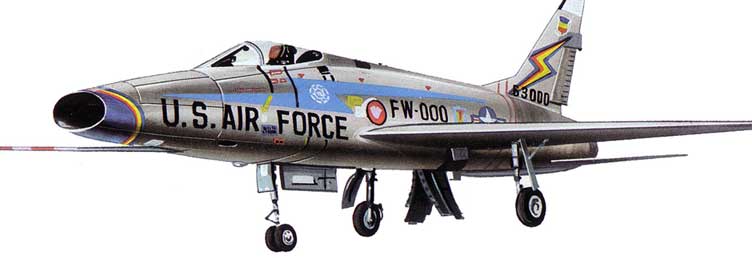
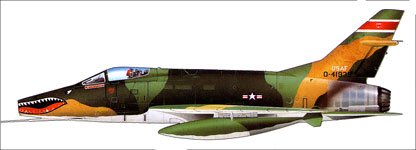 The world's first supersonic fighter interceptor belonged to the same family
as the famous F-86 Sabre. In February, 1949, Ray Rice and Ed Schmued undertook
design studies for a developed version of the F-86 which was to have a 45-degree
angle of sweep on the wings and use a new Pratt & Whitney jet engine which
could develop three times the thrust of the Sabre's engine: the aim was to build
a fighter which could exceed the speed of sound even in level flight.
The world's first supersonic fighter interceptor belonged to the same family
as the famous F-86 Sabre. In February, 1949, Ray Rice and Ed Schmued undertook
design studies for a developed version of the F-86 which was to have a 45-degree
angle of sweep on the wings and use a new Pratt & Whitney jet engine which
could develop three times the thrust of the Sabre's engine: the aim was to build
a fighter which could exceed the speed of sound even in level flight.
The "Sabre 45" was offered to the USAF as a supersonic all-weather fighter but the military requested North American to concentrate on a daytime interceptor role. On November 1, 1951, the USAF ordered two prototypes of the new aircraft from the company, designating them YF- 100. In 1952, this designation was changed to YF-100A to reflect the numerous modifications which had been made to the original design.
On May 25, 1953, George Welch took off from Edwards Base, where
the Air Force Flight Test Center was located, in the YF-100A and broke the
sound barrier during this maiden flight. The Super Sabre, as the plane came
to be known, was a cantilever low-wing monoplane, with 45 degree sweep-back,
powered by a two-stage Pratt & Whitney J57-P-7 with afterburner, the oval
air intake being horizontally positioned in the nose. 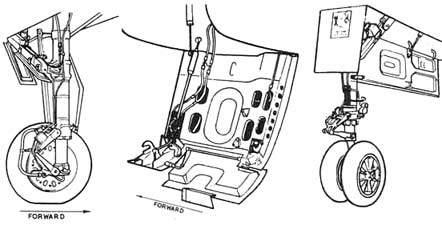
The wings were equipped with leading-edge slats and hydraulically operated slatted ailerons on the trailing edge. The tailplane's also had 45-degree sweep back and were fully powered, located very low on the rear end of the fuselage. The engine and afterburner were installed in the rear fuselage and the pressurized and air conditioned cockpit was fitted with an ejector seat; the canopy was of clamshell design, faired into the tailplane by means of a dorsal spine.
On the F-100A, the underside of the fuselage was an airbrake and the container for the brake-chute. In the front strut of the tricycle landing gear had double truck and retracted into the fuselage while the side struts retracted into the wings. In the F-100 program it was the first time that a very large proportion of titanium was used in aircraft construction, invaluable for its strength and lightness and this sent construction costs soaring.
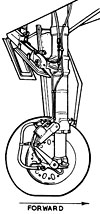 Backed
by the first prototype's success, the new plane went into full production,
and the first F-100A flew as early as October 29, 1953, only a matter of days
after the second prototype had started flight testing on October 14. That
same day the commanding officer of the Air Force Flight Test Center, Lt. Col.
Frank K. Everest, known to his friends as "Speedy Pete" broke the
world speed record in the first YF-100A, reaching 755.149mph at Salton Sea.
Two years later, on August 20, 1955, an F-100C managed to do even better,
at 822.135mph.
Backed
by the first prototype's success, the new plane went into full production,
and the first F-100A flew as early as October 29, 1953, only a matter of days
after the second prototype had started flight testing on October 14. That
same day the commanding officer of the Air Force Flight Test Center, Lt. Col.
Frank K. Everest, known to his friends as "Speedy Pete" broke the
world speed record in the first YF-100A, reaching 755.149mph at Salton Sea.
Two years later, on August 20, 1955, an F-100C managed to do even better,
at 822.135mph.
But all was not well... a series of accidents had started to worry designers and those responsible in the USAF for overseeing the program; when the first test pilot of the Super Sabre, George Welch was killed while testing the plane to the limits of its structural strength, all F-100As which had already been delivered to 479th Group were grounded. A month went by before it was discovered that the tailplane fin was not large enough or strong enough for control of the plane under certain flight conditions. The aircraft currently in production had their fin and rudder surface area increased by 27 percent and all aircraft which had already been delivered were similarly modified, solving the problem.
In February, 1955, the F-100As were cleared and put back into
service, by which time production of this series had ended, with a total of
203 built, and the assembly lines switched to the series C, ground attack
variant. A total of 476 of these F-100C fighter-bombers left the assembly
lines, with a redesigned strengthened "Wet Wing," so called because
of the fuel no longer being contained inside special tanks in the wing but
free-flowing inside the wing structure, increasing capacity. Hard points for
bombs and missiles had been increased to six.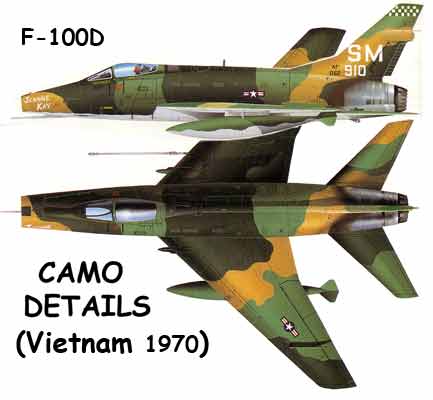
The next variant, the F-100D, was also a fighter-bomber and 1,274 were built.. these had larger vertical tailplane's and flaps on the trailing edge of the wing; an autopilot system was installed, as was a rearward-looking warning radar and the LABS (Low Altitude Bombing System); these series aircraft also had in-flight refueling capability. The F-100D was equipped to carry and launch nuclear warheads.
F-100F Version:
The last F-100 version, the F series, was based on a prototype
which had originally been designated TF-100C, a stretched fuselage two-seat
trainer which was fully equipped for combat missions but with reduced armament,
having two 20mm cannons instead of the four standard in other variants.
A total of 339 F-100Fs were built and the entire Super Sabre production
run ended when the last of these left the assembly lines in October 1959.
The B variant of the F-100 never went into production under this designation; an all-weather model, it was much faster and more powerful than the basic variant and was eventually redesigned and produced as the F- 107. The F- 100D and some F- 100F aircraft were used to carry out important research into the possibility of assisted take-off or, more accurately "rocket launching" these aircraft from mobile launching pads, such as an especially built launching truck.
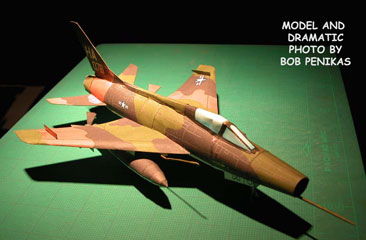 |
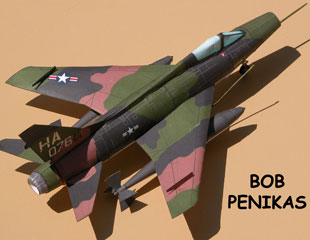 |
| Here's tonight's snap shot of your
completed F-100 with your tanks. The photo taken under a one room
light may be a bit "dramatic" but I thought you would like
to see this. Thank you again for all your effort and keep up the good
work...please, Bob Penikas 6/02 |
|
On May 18, 1958, an F-100A took off in a ZEL (Zero Length Launch) experiment, with no runway at all, propelled into the air by its own engine in afterburner, boosted by a 130,0001b thrust Astrodyne rocket.
The takeoff was, in fact, a lift-off. The purpose of these experiments was to explore the possibilities of aircraft being able to take off from places far away from conventional airfields, since the latter would probably be among the first places to be destroyed by the enemy in case of war.
After approximately five years' front line service the F- 100s were gradually replaced by the F-105 or by Phantoms and they were relegated to use by 19 Squadrons of the Air National Guard which used them until 1980.
From 1956, F-100C planes were chosen by two very demanding
users, the USAF aerobatic teams, the "Thunderbirds" in the States
and the "Skyblazers" in Europe, both of these display teams flying
them for many years at hundreds of air shows. The F-100 first saw action
when they were already becoming obsolescent: during the Gulf of Tonkin crisis
in 1966, when four Super Sabre Wings were recalled into service and sent
to Vietnam where they continued to serve until 1971, during which time these
(relatively few) planes flew more combat missions than the total flown by
16,000 Mustangs during World War 11. Third Tactical Fighter Bomber Wing.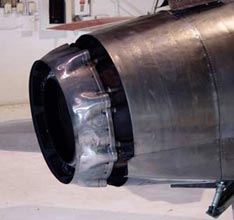
Turkish Air Force F-100F alone completed more than 100,000 missions by
the end of l969. When assigned to close support duties or used as ECM platforms
these Super Sabre's proved excellent warplanes and many a pilot, when converting
to different, more up-to-date airplanes, regretted parting with his old "
Hun " (from " Hundred "). Although the F- 100 may have been
assigned the number by coincidence, the Super Sabre was the plane selected
to inaugurate the "Century Series" of fighters and this, the USAF's
first supersonic plane was a worthy choice. Other users of the F-100 purchased
their aircraft under the Mutual Assistance program implemented in 1959, under
which USAF planes which were "surplus to requirements" were ceded
to friendly countries.
As already noted, the F-100 had the reputation of being a dangerous plane at one point: 95 accidents for 100,000 flying hours, even though few of these involved fatalities. Today, however, the record shows that the average total of flying hours clocked up by each F- 100 is a very impressive 5, 100 and this must have earned the plane a better reputation. The Super Sabre was an extremely advanced plane in its day and merits respect for its influence on later combat planes. President Eisenhower echoed the whole aeronautical fraternity's admiration for the Super Sabre when he honored North American's president, J. H. Kindelberger, and his design team with the Collier Trophy on December 17, 1954, in recognition of their services to the aviation world.
North American F-100D/F Super Sabre:
 The F-100Ds, last single-seater version of the first American supersonic fighter,
provided with an autopilot and also armed with bombs attached to the underside
of the wings, played an important role in the Vietnam war, with over 300,000
missions from August 1964 to July 1971.
The F-100Ds, last single-seater version of the first American supersonic fighter,
provided with an autopilot and also armed with bombs attached to the underside
of the wings, played an important role in the Vietnam war, with over 300,000
missions from August 1964 to July 1971.
The Super Sabre's, familiarly known as 'Huns,' a shortened version of 'Hundred', were immediately used for low-level night bombing missions, and during the first years of the war pounded objectives in South Vietnam where suspected concentrations of Viet Cong had been sighted. For this type of mission the F-100Ds were armed with two CBU-24 bombs which, on opening, released a large number of anti-personnel devices, and two 750lb napalm bombs.
Once they had dropped their load, the Super Sabre's proceeded to spray the zone under attack with their four 20mm cannons to complete the cleaning up work. Because of their adaptability and, even more, the lack of a real alternative, numerous F-100 Wings were used in Vietnam, some of them consisting of squadrons of the Air National Guard, called up for front line service. The 3rd TFW alone carried out more than 100,000 missions in 1969! From the end of 1965 a number of two-seater F-100Fs, the Wild Weasel 1, carrying anti-SAM electronic equipment, were in action, operating from the Korat base in Thailand.
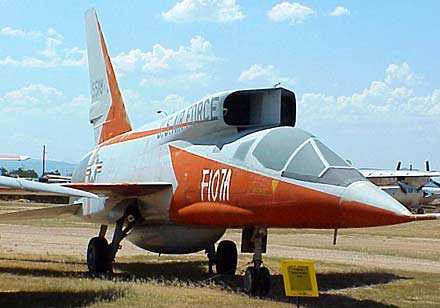
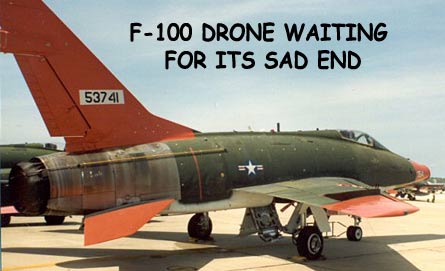
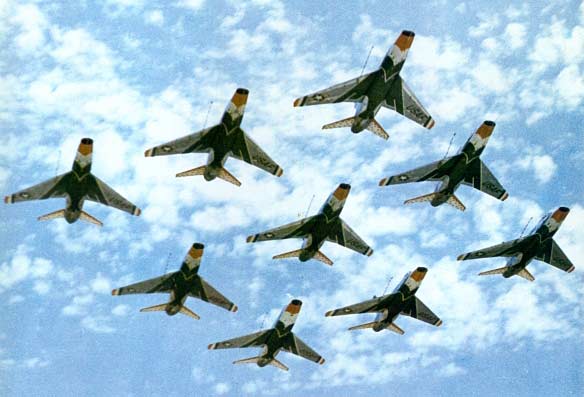
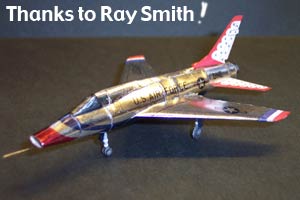
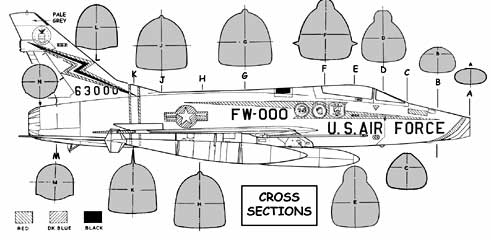
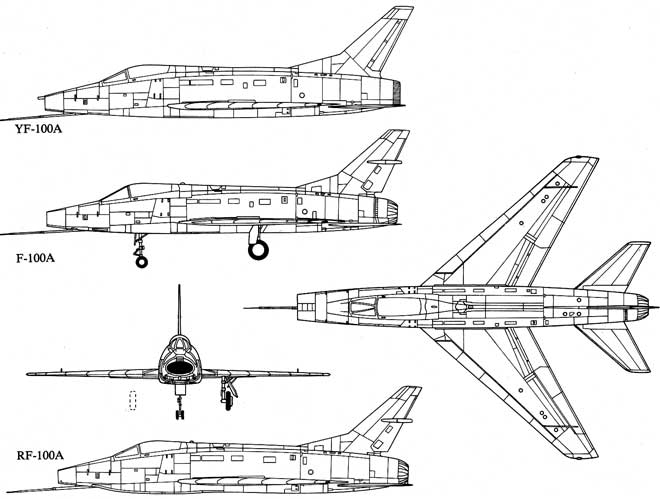
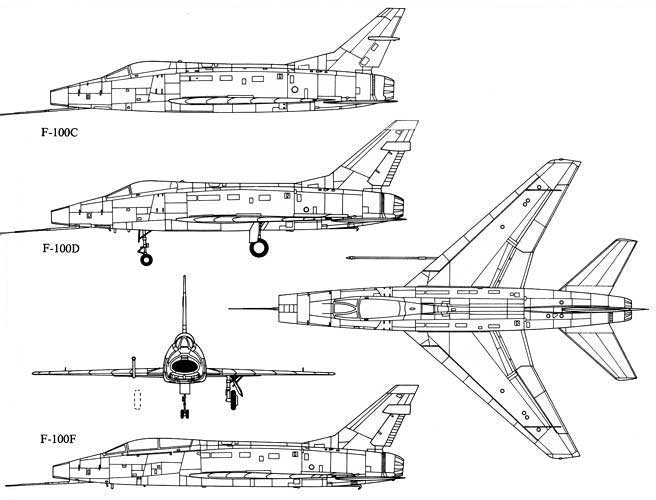
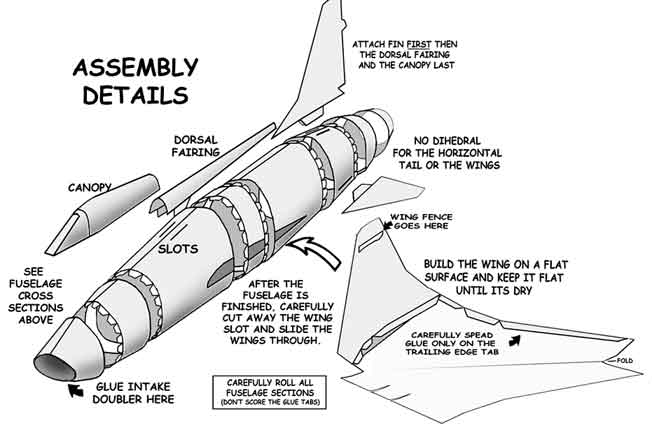
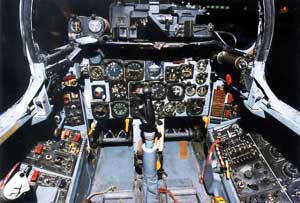 |
North American F-100 Super Sabre Cockpit. |
Specifications for the North American F-100 Super Sabre
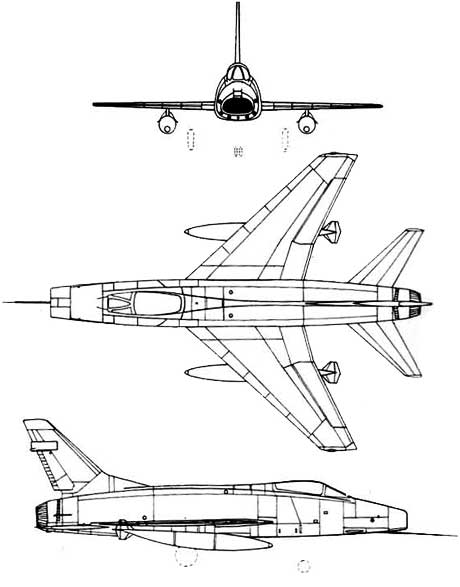 |
Length: 49.51ft External hardpoints for an additional |
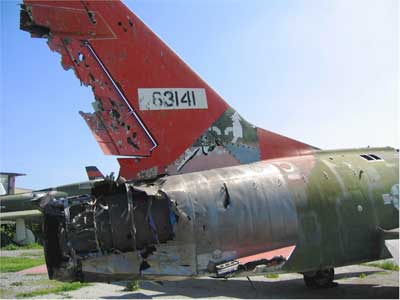 |
The orange tail is a clear indication that North American F-100 Super Sabre #56-3141 was converted to an unmanned QF-100 target drone in the last stages of its airworthy life. In the late 1980s, while being flown by Tracor Flight Systems in Mojave, California, it was the recipient of a missile fired during a U.S. Army test. The entire right-hand stabilator was blown off, along with much of the rudder and afterburner casing and rear fuselage skin. The fact that it was able to return for a landing is impressive. |
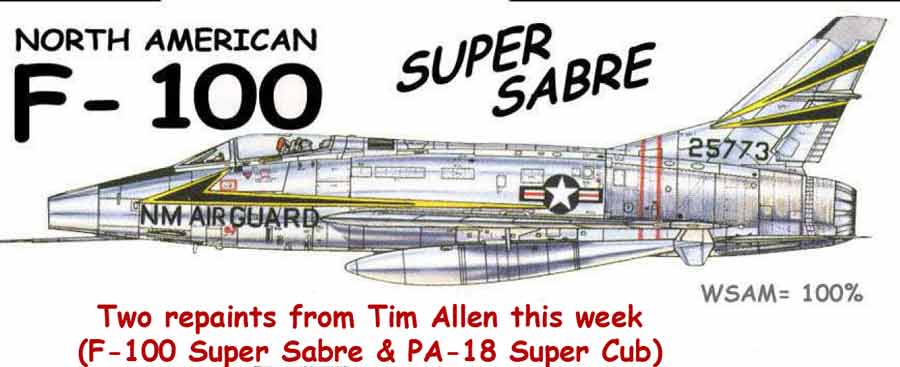 |
Here's a repaint/upgrade to the New Mexico Air National Guard F-100. Basically its just Robs great model but with a new metallic background added on. The panels, lines and lighter/darker patches along with the gradient overlays are supposed to give a greater impression of bare metal. - Tim Allen |


